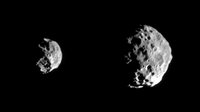 | Target Name: Phoebe, Is a satellite of: Saturn, Mission: Cassini, Spacecraft: Cassini Orbiter, Instrument: Imaging Science Subsystem - Narrow Angle. |
Original Caption Released with Image: Early images returned from the first detailed reconnaissance of Saturn's small outer moon, Phoebe, show breathtaking details in the moon's pockmarked surface that already have imaging scientists puzzling over the body's history. The images are only a preview of what to expect from the high resolution images to be examined later today which will show details about 10 times smaller.
Phoebe has revealed itself to be a rugged, heavily cratered body, with overlapping craters of varying sizes. This morphology suggests an old surface. There are apparently many craters smaller than 1 km, indicating that projectiles probably smaller than 100 meters once pummeled Phoebe. Whether these objects were cometary or asteroidal in origin, or were the debris that resulted from impacts on other bodies within the Saturn system, is hotly debated. There is also variation in surface brightness across the body.
In the first image (at left) in which Phoebe looks somewhat like a sideways skull, the large crater near the bottom displays a complex and rugged interior. The lower right hand part of Phoebe appears to be covered by bright wispy material.
The second, higher resolution image further reveals the moon's battered surface, including a crater near the right hand edge with bright rays that extend outward from its center. This suggests that dark material coats the outside. Features reminiscent of those seen on the Martian moon Phobos -- such as linear grooves--are faintly visible in the upper part of this image. There are suggestions of linear ridges or grooves and of chains of craters, perhaps radial to a large crater just hidden on the un-illuminated region in the upper left.
Left to right, the two views were obtained at phase, or Sun-Phoebe-spacecraft, angles of approximately 86 degrees, and from distances ranging from 143,068 kilometers (88,918 miles) to 77,441 kilometers (48, 130 miles); for reference, Cassini's closest approach to Phoebe was approximately 2,068 kilometers (1,285 miles). The image scale ranges from 0.86 to 0.46 kilometers (0.53 to 0.29 miles) per pixel. No enhancement of any kind has been performed on the images.
The Cassini-Huygens mission is a cooperative project of NASA, the European Space Agency and the Italian Space Agency. The Jet Propulsion Laboratory, a division of the California Institute of Technology in Pasadena, manages the Cassini-Huygens mission for NASA's Office of Space Science, Washington, D.C. The Cassini orbiter and its two onboard cameras, were designed, developed and assembled at JPL. The imaging team is based at the Space Science Institute, Boulder, Colo.
For more information, about the Cassini-Huygens mission visit, saturn.jpl.nasa.gov and the Cassini imaging team home page, ciclops.org. Image Credit: NASA/JPL/Space Science Institute
NASA images generally are not copyrighted. Unless otherwise noted, images and video on JPL public web sites (public sites ending with a jpl.nasa.gov address) may be used for any purpose without prior permission. The endorsement of any product or service by Caltech, JPL or NASA must not be claimed or implied.
Leave a comment, make a request, Let this small sampling be a guide to better quality, more plentiful, public domain, royalty free, copyright free, high resolution, images, stock photos, jpeg, jpg, free for commercial use, clip art, clipart, clip-art. more at Public Domain Clip Art and clip art or public domain and Space or NASA and Cassini-Huygens or Saturn and European Space Agency or Phoebe













No comments:
Post a Comment